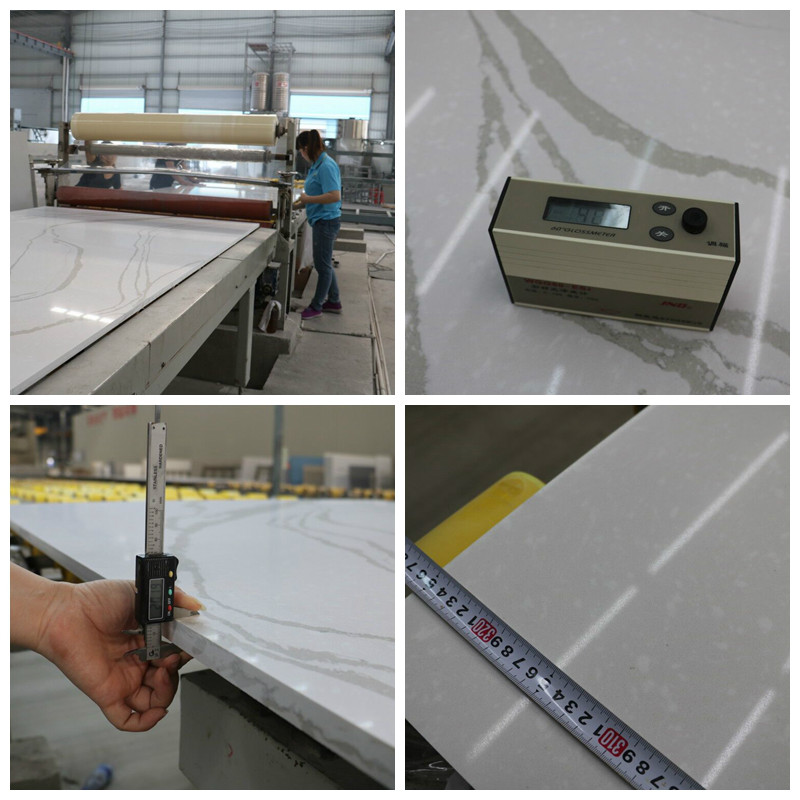
Quartz stone is a popular material used in various construction and interior design projects. Its blend of natural beauty and engineered durability makes it an excellent choice for surfaces like countertops, flooring, and walls. A key consideration when selecting quartz stone is its thickness, which affects both the visual aesthetics and functional performance of the material. Understanding the different thicknesses of quartz stone, as well as their applications, is crucial for achieving the desired outcome in any space.
The most common quartz slab thicknesses are 1 cm, 2 cm, and 3 cm. Each thickness is suited for specific applications, depending on factors like structural support, weight, durability, and aesthetics.
The thinnest option available, 1 cm quartz slabs are lightweight and ideal for areas where weight is a concern. These thin slabs are often used for vertical applications, such as wall cladding and backsplashes because they do not require the same level of support as thicker slabs. Since 1 cm quartz stone is relatively thin, it can also be used in furniture pieces or decorative applications where thickness is less important but the visual appeal of quartz is still desired.
A versatile and commonly used thickness, 2 cm quartz slabs are typically used in countertops and other work surfaces. This thickness provides a balance between strength and manageability. While slightly thinner than the more robust 3 cm slabs, 2 cm quartz is still highly durable and suitable for most residential and commercial applications. In addition, it offers a sleeker profile, which is often preferred for modern, minimalist designs.
The thickest and most durable option, 3 cm quartz slabs are widely used in heavy-duty applications where both strength and aesthetics are crucial. This thickness is ideal for kitchen countertops, bathroom vanities, and other surfaces that need to withstand significant wear and tear. The increased thickness also enhances the overall visual impact of the stone, making it a standout feature in any space. However, due to its heavier weight, it requires more structural support than thinner slabs.
Quartz stone is incredibly versatile, and different thicknesses lend themselves to various types of applications. Below are the common uses for each thickness.
1 cm quartz slabs are an excellent choice for vertical applications like wall cladding, backsplashes, and fireplace surrounds. These areas don’t require the durability needed for heavy traffic surfaces, allowing designers to prioritize aesthetics. Additionally, thin quartz stone is often laminated onto other materials such as plywood or MDF to provide a lightweight yet beautiful finish. It is also commonly used in decorative panels, furniture inlays, or tabletops.
Because the material is thinner and more flexible, it can be installed with fewer concerns about weight, making it easier to apply in areas that are more challenging for thicker materials. However, it is less suitable for horizontal surfaces that are subject to high impact or heavy loads, as it may be more prone to chipping or cracking under stress.
The 2 cm thickness is ideal for countertops in kitchens and bathrooms, particularly in residential settings. It strikes a balance between affordability and strength, making it the most popular choice for homeowners. This thickness is durable enough to handle daily wear and tear while offering a sleek, modern appearance. Because 2 cm quartz is lighter than 3 cm, it is also easier to handle during installation, reducing labor costs and complexity.
For applications like kitchen islands or bathroom vanities, a 2 cm slab offers the necessary durability without the need for additional reinforcement. When combined with a laminated edge, it can mimic the appearance of thicker slabs without the additional cost or weight, offering more design flexibility.
When durability and longevity are a priority, 3 cm quartz stone is the ideal option. This thickness is frequently used in high-traffic commercial spaces such as restaurants, hotels, and office buildings where surfaces need to withstand constant use. Its thickness makes it extremely durable, resistant to cracks, and more forgiving under heavy impacts.
For residential projects, 3 cm quartz is often seen in high-end kitchen and bathroom designs. The thicker slab adds a sense of luxury and grandeur to countertops, offering a more substantial, premium look. Because it does not require additional backing for support, 3 cm slabs are a straightforward option for creating sturdy and visually striking surfaces.
The choice of quartz stone thickness ultimately depends on the specific requirements of the project. If you are working on vertical surfaces, decorative applications, or areas where weight is a concern, thinner slabs like 1 cm quartz are a cost-effective and aesthetically pleasing option. For countertops and surfaces that require a balance between durability and design flexibility, 2 cm quartz provides the best of both worlds. Finally, if strength, longevity, and visual impact are your top priorities, 3 cm quartz slabs offer unparalleled performance and style.
Quartz stone is a versatile and durable material that can be tailored to suit a wide range of applications by adjusting its thickness. Whether you are designing a sleek, modern kitchen, a luxurious bathroom, or a stylish feature wall, understanding the impact of different quartz thicknesses will help you make informed decisions that align with your project’s functional and aesthetic goals. By choosing the appropriate quartz thickness, you ensure a beautiful, long-lasting result that enhances the overall design of your space.